Approximations for higher order boundary value problems using non-polynomial quadratic spline based on off-step points
⁎Corresponding author. akhan2@jmi.ac.in (Arshad Khan)
-
Received: ,
Accepted: ,
This article was originally published by Elsevier and was migrated to Scientific Scholar after the change of Publisher.
Peer review under responsibility of King Saud University.
Abstract
Non-polynomial quadratic spline method based on off-step points is used to develop a numerical algorithm for obtaining an approximate solution of higher even order boundary value problems. For the employment of the method, decomposition procedure is used. Higher order boundary value problems are reduced into the corresponding system of second order boundary value problems. Convergence analysis of the method is also discussed. Seven numerical examples are given to illustrate the applicability and efficiency of new method. It is also shown that the new method gives approximations, which are better than those produced by other existing fourth order methods except higher degree splines.
Keywords
Higher order
Singular
Non-linear
Second order
Non-polynomial quadratic spline
Off-step points
Convergence analysis
1 Introduction
The higher order boundary value problems have been studied as their mathematical applications are in diversified applied sciences. Conditions for the existence and uniqueness of solutions of the higher-order boundary-value problems was discussed in Agarwal (1986, pp. 89–93). Several numerical algorithms have been developed to determine the approximate solution of higher-order boundary-value problems. In this paper, we consider the higher order boundary value problems of the form
-
-
-
These conditions from Keller (1968, (pp. 6–8 and 15–16)) ensure the existence and uniqueness of the solution of the above boundary value problem (3) and (4).
Here, our aim is to solve the boundary value problems of fourth, sixth and eighth orders of the form (1) and (2) with
The above system involves the second order boundary value problems. Polynomial and non-polynomial spline approach (Ramadan et al., 2007), quintic non-polynomial spline method (Srivastava et al., 2011), cubic spline method (Al-Said, 2001), non-polynomial spline (Jha and Mohanty, 2011; Mohanty et al., 2017), spline in tension (Mohanty et al., 2005), spline in compression (Mohanty et al., 2004) were used in previous papers to solve second order boundary value problems. Here, we use lower degree non-polynomial quadratic spline for solving system of second order boundary value problems. This non-polynomial quadratic spline is based on off-step points.
When linear BVPs are implemented over the method, we get a linear system of equations which are solved by using LU decomposition method and when non-linear BVPs are implemented we get a non-linear system which is solved by Block Newton Raphson method. The outline of this paper is organised into five sections. In Section 2, consistency relation and in Section 2.1 truncation error and end equations are discussed. In Section 3, application of the method to solve the sixth order BVPs is given. Section 4 gives the convergence analysis of the method. In Section 5, seven examples are considered to illustrate the accuracy and performance of the method presented in the paper.
2 Non-polynomial quadratic spline function
To develop the new method based on off-step points, we divide the interval
Let
To determine the coefficients
Using the continuity of first derivative,
2.1 Truncation error
Expanding the scheme (7) by using Taylor series, we obtained the following truncation error
For different values of parameters, we get the second as well as fourth order method. For
Eq. (7) forms a system of
The equations for second order method are given by Islam et al. (2006) as
The truncation error for second order method for
The truncation error for the fourth order method is given as follows:
3 Application of the algorithm to the higher order boundary value problems for
We consider a sixth order boundary value problem i.e N = 3 in (1–2) of the form
Therefore by implementing the scheme (7) on the boundary value problems (15)–(17), we get the following system of equations
The fourth order method is obtained by using the parameters
4 Convergence analysis
In this section, we study the convergence analysis of the second order method developed in Section 2 where
We also have,
Then
To show matrix A is monotone first we calculate the sum of each row of the matrix A.
Hence,
Therefore,
5 Numerical Illustrations
We now consider seven numerical examples involving higher order non-linear and linear boundary value problems along with two singular problems involving first and third derivatives illustrating the efficiency of the presented method. We compared the results with the existing methods of fourth order. We have also provided the numerical rate of convergence
Consider the following fourth order non-linear boundary value problem for
Consider the following sixth order non-linear boundary value problem as
For
For
Consider the following sixth order linear boundary value problem as
Consider the following non-linear singular fourth order boundary value problem as
Consider the following non-linear singular fourth order boundary value problem as
| Our Method |
|
|
|
|---|---|---|---|
| Fourth order method for
|
|
|
|
| Second order method for
|
|
|
|
| Wazwaz (2002) |
|
– | – |
| Our Method |
|
|
|
|---|---|---|---|
| Fourth order method for
|
|
|
|
| Khan and Khandelwal (2012) |
|
|
|
| Second order method for
|
|
|
|
| Islam et al. (2008) |
|
|
|
| Our Method |
|
|
|
|---|---|---|---|
| Fourth order method for
|
|
|
|
| Khan and Khandelwal (2012) |
|
|
|
| Second order method for
|
|
|
|
| Khan and Khandelwal (2012) |
|
|
– |
| Our Method |
|
|
|
|---|---|---|---|
| Fourth order method for
|
|
|
|
| Second order method for
|
|
|
|
| Meŝtroviĉ (2007) |
|
– | – |
| Our Method |
|
|
|
|---|---|---|---|
| Fourth order method for
|
|
|
|
| Islam et al. (2008) |
|
|
|
| Second order method for
|
|
|
|
| Islam et al. (2008) |
|
|
|
| Our Method |
|
|
|
|---|---|---|---|
| Fourth order method for
|
|
|
|
|
|
|
|
|
| Mohanty et al. (2017) |
|
|
|
| Second order method for
|
|
|
|
| Our Method |
|
|
|
|---|---|---|---|
| Fourth order method for
|
|
|
|
|
|
|
|
|
| Second order method for
|
|
|
|

- Graph of the exact solution versus the approximate solution for N = 16 for Example 5.1.

- Graph of the exact solution versus the approximate solution for N = 32 for Example 5.2.
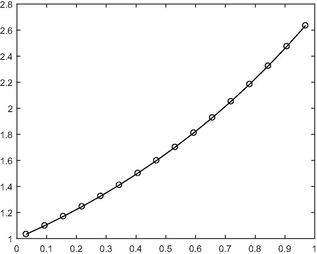
- Graph of the exact solution versus the approximate solution for N = 16 for Example 5.3.
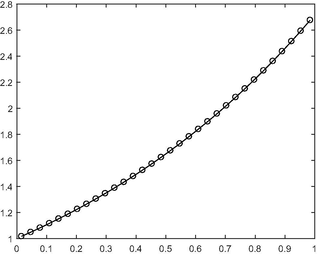
- Graph of the exact solution versus the approximate solution for N = 32 for Example 5.4.
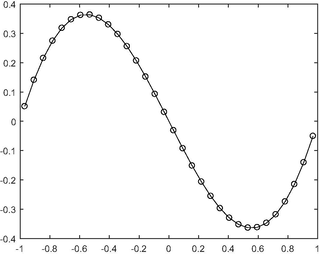
- Graph of the exact solution versus the approximate solution for N = 32 for Example 5.5.
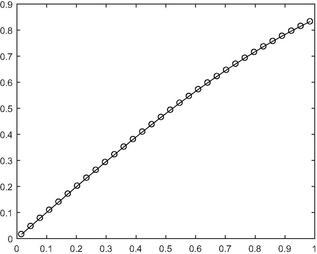
- Graph of the exact solution versus the approximate solution for N = 32 for Example 5.6.
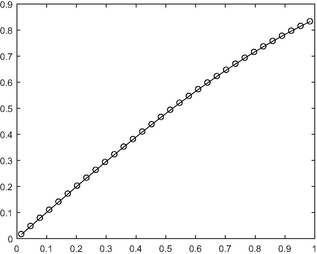
- Graph of the exact solution versus the approximate solution for N = 32 for Example 5.7.
6 Conclusion
In this paper, we developed a non-polynomial quadratic spline method based on off-step points for solving higher even order boundary value problems. Advantage of the off-step points is to solve the higher order singular boundary value problems. We reduced the given problem into system of second order boundary value problems. The developed scheme (7) is second as well as fourth order accurate depending upon the parameters. Comparison of our method with the existing methods are shown in Tables 1–6 and graphs between exact and approximate solutions of the Examples 5.1–5.7 are shown in Figs. 1–7 respectively. These results shows that our fourth order method is far better than the existing fourth order methods except higher degree splines.
Acknowledgements
First author is thankful to UGC for providing MANJRF. The authors are also thankful to the referees for their useful suggestions which greatly improved the quality of the paper.
References
- Boundary Value Problems for Higher-Order Differential Equations. Singapore: World Scientific; 1986.
- Solution of sixth-order boundary value problems using non-polynomial spline technique. Appl. Math. Comput.. 2006;181:708-720.
- [Google Scholar]
- The use of cubic splines in the numerical solution of a system of second-order boundary value problems. Comput. Math. Appl.. 2001;42:861-869.
- [Google Scholar]
- Numerical methods for the solution of special sixth order boundary-value problems. Int. J. Comput. Math.. 1992;45:207-223.
- [Google Scholar]
- Quadratic non-polynomial spline approach to the solution of a system of second-order boundary-value problems. Appl. Math. Comput.. 2006;179:153-160.
- [Google Scholar]
- Non-polynomial splines approach to the solution of sixth-order boundary value problems. Appl. Math. Comput.. 2008;195:270-284.
- [Google Scholar]
- Convergence analysis of nonic-spline solutions for special nonlinear sixth-order boundary value problems. Commun. Nonlinear Sci. Numer. Simul.. 2010;15:3805-3813.
- [Google Scholar]
- TAGE iterative algorithm and non-polynomial spline basis for the solution of non-linear singular second order ordinary differential equations. Appl. Math. Comput.. 2011;218:3289-3296.
- [Google Scholar]
- Numerical Methods for Two Point Boundary Value Problems. New York: Blaisdell Publications Co; 1968.
- Solution of non-linear sixth-order two point boundary-value problems using parametric septic splines. Int. J. Nonlin. Sci.. 2012;2:184-195.
- [Google Scholar]
- The modified decomposition method for eighth-order boundary value problems. Appl. Math. Comput.. 2007;188:1437-1444.
- [Google Scholar]
- Spline in compression method for the numerical solution of singularly perturbed two point singular boundary value problems. Int. J. Comput. Math.. 2004;81:615-627.
- [Google Scholar]
- Convergent spline in tension methods for singularly perturbed two point singular boundary value problems. Int. J. Compu. Math.. 2005;82:55-66.
- [Google Scholar]
- Non-polynomial cubic spline discretization for system of non-linear singular boundary value problems using variable mesh. Adv. Diff. Eqs.. 2017;327
- [Google Scholar]
- Polynomial and non-polynomial spline approaches to the numerical solution of second order boundary value problems. Appl. Math. Comput.. 2007;184:476-484.
- [Google Scholar]
- Solution of eighth-order boundary value problems using the non-polynomial spline technique. Int. J. Comput. Math.. 2007;84:347-368.
- [Google Scholar]
- Quintic non-polynomial spline method for the solution of a second-order boundary-value problem with engineering applications. Comput. Math. Appl.. 2011;62:1707-1714.
- [Google Scholar]
- Matrix Iterative Analysis. Englewood Cliffs, NJ: Prentice-Hall; 1962.
- The numerical solution of special fourth order boundary value problems by modified decomposition method. Int. J. Comput. Math.. 2002;79:345-356.
- [Google Scholar]







